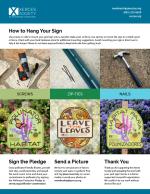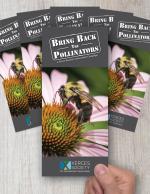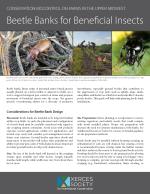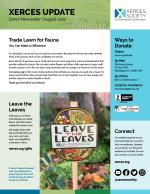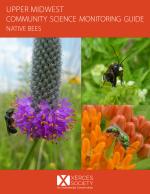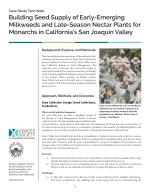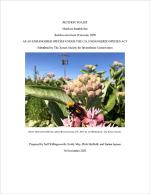As a science-based organization, the Xerces Society produces dozens of publications annually, all of which employ the best available research to guide effective conservation efforts. Our publications range from guidelines for land managers, to brochures offering overviews of key concepts related to invertebrate conservation, from books about supporting pollinators in farmland, to region-specific plant lists. We hope that whatever you are seeking—whether it's guidance on making a home or community garden pollinator-friendly, advice on developing a local pesticide reduction strategy, or detailed information on restoring habitat—you will find it here!
Find Publications
Use the search functions to sort by publication type (books, guidelines, fact sheets, etc.), location, and/or subject (agriculture, gardens, pollinators, pesticides, etc.).
Application information
The Xerces Society is now accepting applications for a minimum of two awards to support students pursuing education and research into Lepidoptera conservation. Award amounts are determined annually, but are a minimum of $3,750 each.
An instructional insert explaining how to hang a Xerces sign from the gift center.
Pollinators are essential to the health of our environment and for bountiful farm crops. There are four straightforward steps that you can take to help them: grow flowers, provide nest sites, avoid pesticides, and share the word.
Conservation Biocontrol on Farms in the Upper Midwest
This fact sheet provides information on planning, locating, and installing beetle banks in the Upper Midwest, including recommended grasses and flowers that can be planted. Beetle banks are linear strips of perennial native bunch grasses that provide overwintering shelter for predatory ground beetles, spiders, and other beneficial invertebrates.
By Rich Hatfield, Ann Potter (WDFW), and Joel Sauder (IDFG)
Bumble bees are charismatic and easily recognizable pollinators thanks to their large size and distinctive striped patterns, usually of black and yellow, but often with stripes of red, orange, or white. They play an incredibly important role in keeping our environment healthy by pollinating flowers in natural areas and by contributing to successful harvests on farms.
Our donor newsletter that includes news and information about Xerces' programs and conservation work.
Developed for community scientists (sometimes referred to as "citizen scientists") to document how native bee communities change through time in pollinator habitats. It includes an introduction to bee identification, an overview of biology, tools for identifying different groups of bees, and observation datasheets.
In the past twenty years, only 15 species of bumble bees have been observed in Nebraska, five fewer species than historically recorded between 1800–2001. The most immediate and productive steps that we can take to conserve these imperiled pollinators is to intentionally manage and restore existing habitat and/ or create additional habitat. The recommendations in this guide combine the latest understanding of bumble bee habitat needs with lessons learned from the Nebraska Bumble Bee Atlas (NEBBA).
(N Extension EC1564)
Nebraska is home to 20 species of bumble bees that play a critical role in sustaining the health of our environment. This pocket guide is intended to aid community scientists in identifying bumble bees without a microscope.
Site preparation is one of the most important and often inadequately addressed components for successfully installing pollinator habitat. These guidelines provide step-by-step instructions, helpful suggestions, and regional timelines & checklists for preparing both small and large sites


